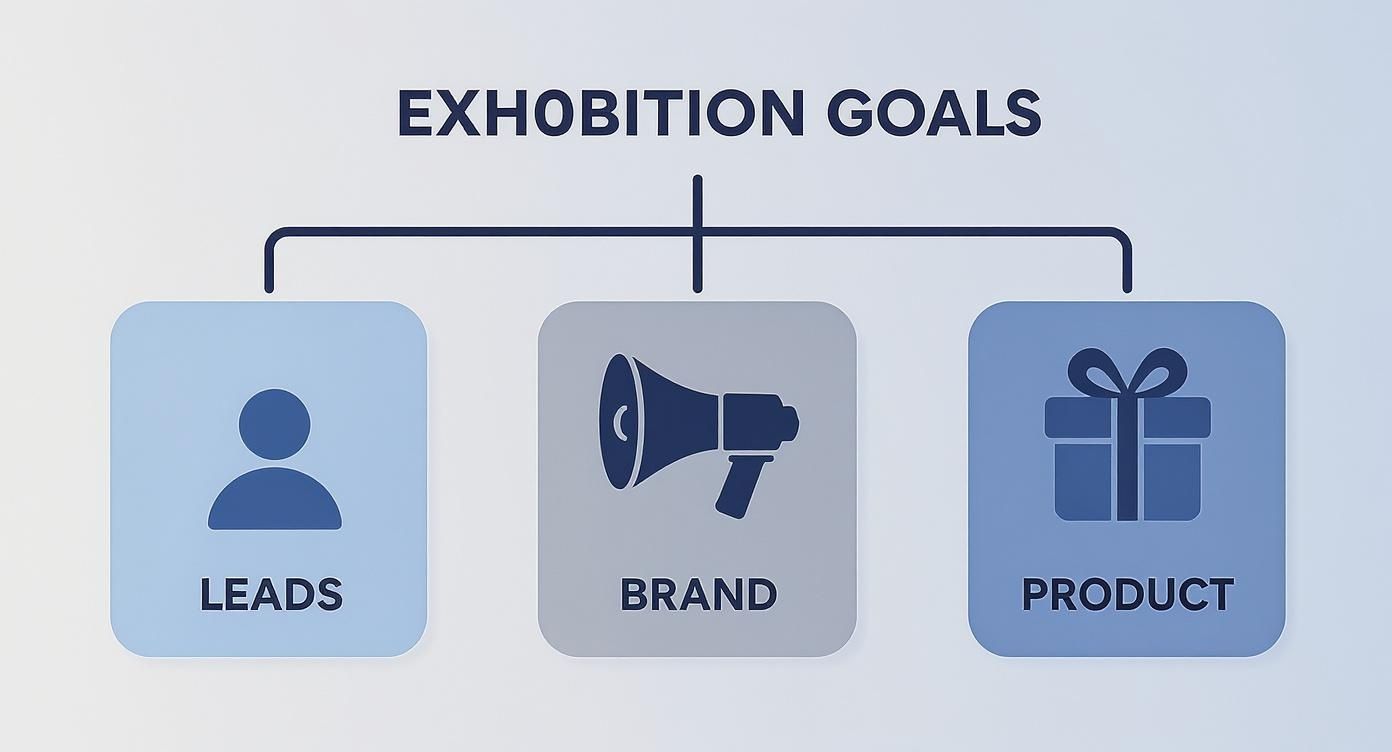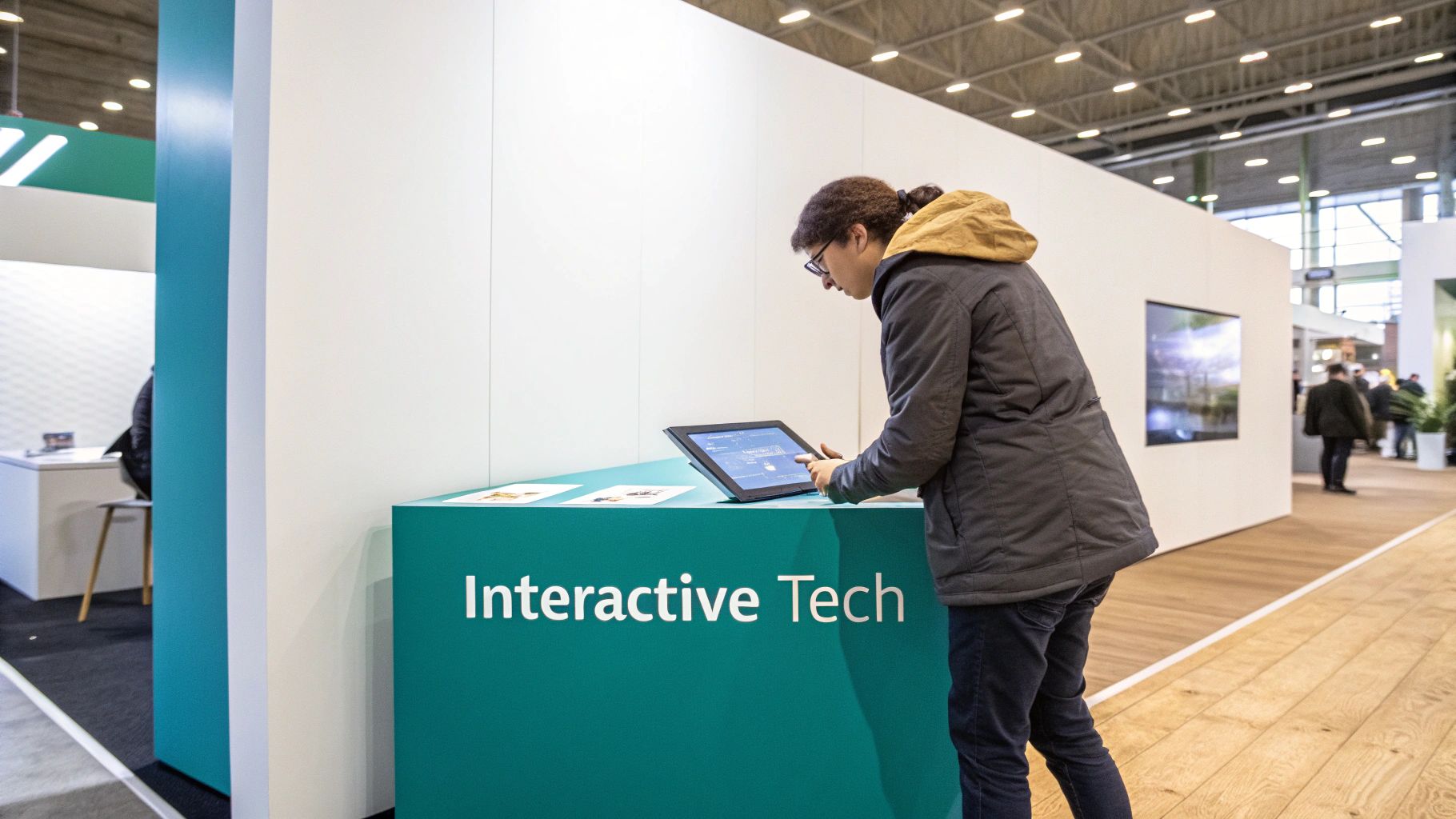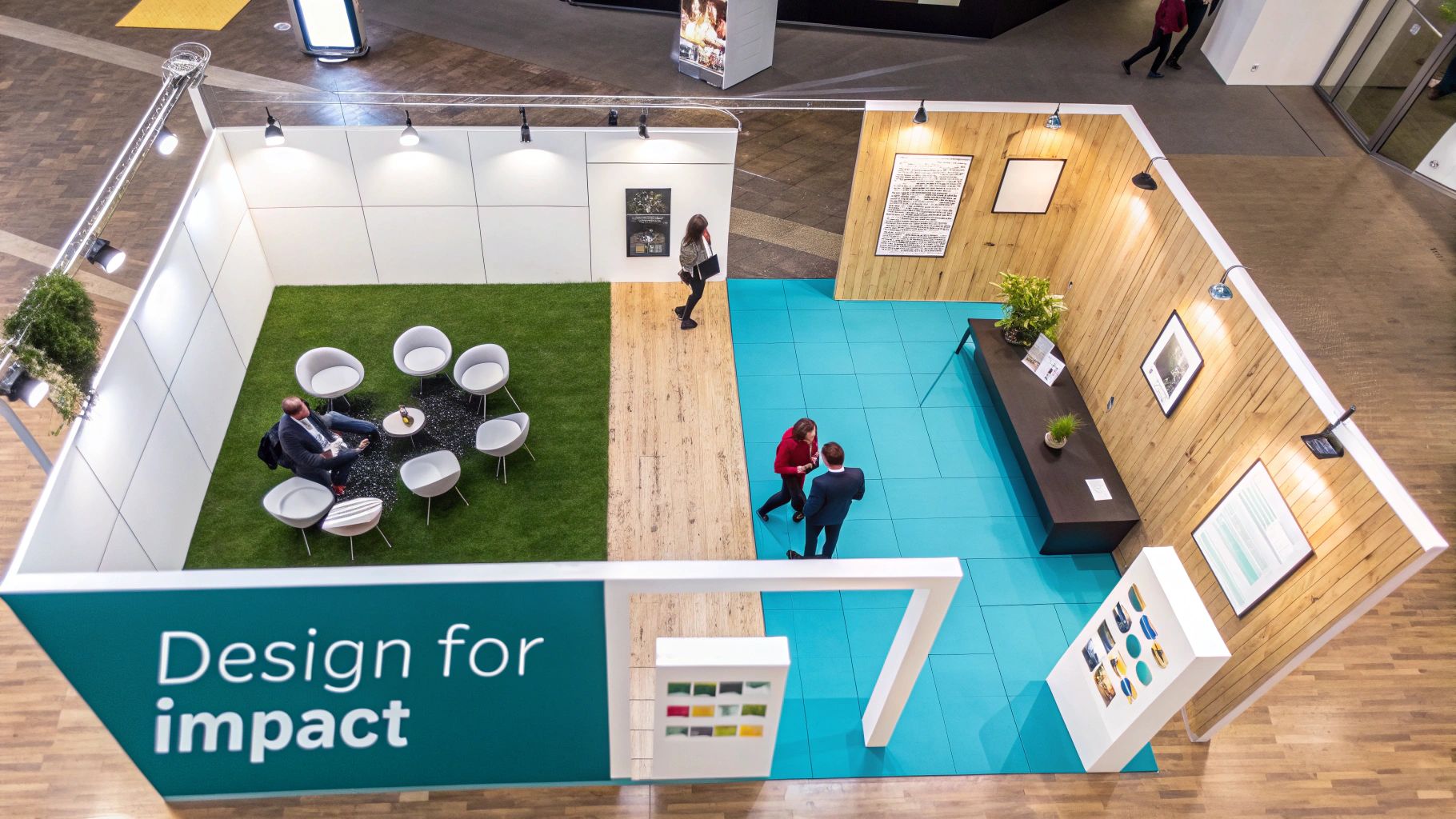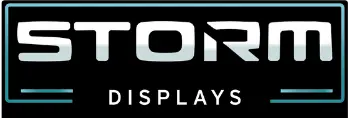You’re booked for the biggest trade show of the year, but how do you ensure your investment pays off? A stunning exhibition stand is more than just a structure; it’s a strategic tool designed to achieve specific business objectives. Whether your goal is to generate a flood of new leads, launch a game-changing product, or solidify your brand’s presence, every design decision must be driven by your goals.
Aligning Your Booth Design with Your Business Goals
Before you start picking colors or designing graphics, the most important question to ask is: What are we trying to accomplish at this event? A beautiful booth that doesn't start conversations or capture qualified leads is an expensive missed opportunity. The first step is to anchor your entire design concept in clear, measurable business objectives. This process turns abstract goals into a physical space engineered for success.
Define Your Primary Objective
Are you attending the show to fill your sales pipeline for the next quarter? Are you planning a major splash with a new product reveal? Or is your main aim to cement your company's reputation as an industry leader? Your primary goal will set the tone for the entire project.
-
Lead Generation: Your design needs to facilitate interaction and seamless data capture. Think open, welcoming layouts, integrated tablets for quick sign-ups, and clear pathways that guide attendees toward your demo stations. You are building a conversation hub.
-
Brand Awareness: To build brand buzz, your booth must be a landmark on the show floor. Go for bold, towering graphics, a unique architectural shape, or an immersive brand experience that people will be talking about long after the event. You want to be a "must-see" destination.
-
Product Launch: When launching a product, it is the undisputed star of the show. Your design must build anticipation and draw every eye toward it. Use dramatic lighting, interactive product displays, and a clutter-free central stage to let your innovation shine.
A well-crafted design brief gets everyone—from your marketing team to your stand builder—on the same page, ensuring every element serves a distinct purpose. It is a critical step in creating an exhibition stand design that delivers tangible, measurable results.
A clear objective is what separates a booth that just looks good from one that actively works to grow your business. It transforms your physical footprint into a powerful engine for engagement.
The resurgence of the trade show industry highlights the value of face-to-face connections. In 2023, the UK events sector contributed an incredible £61.65 billion to the economy, and the number of major exhibitions reached its highest level since 2017. This isn't just an interesting statistic; it's proof that a strategic booth is an investment in a thriving marketing channel.
You can see how this all fits together by checking out our complete guide to building a trade show marketing strategy.
To make this connection crystal clear, we've created a table to help you align your goals with specific, tangible design features.
Connecting Booth Features to Business Goals
Use this table to align your primary trade show objectives with tangible design elements, ensuring your investment delivers measurable results.
| If Your Goal Is… | Your Design Should Focus On… | Practical Feature Example |
|---|---|---|
| Generate High-Quality Leads | Creating spaces for conversation and easy data collection. | Semi-private meeting pods with integrated charging stations and QR codes linking to a contact form. |
| Boost Brand Awareness | Making a memorable visual impact that stands out from the crowd. | A towering, uniquely shaped structure with dynamic LED video walls displaying bold brand visuals. |
| Launch a New Product | Drawing all attention to the product and its key features. | A central, elevated product pedestal with dramatic spotlighting and interactive touchscreens for specs. |
| Educate Your Audience | Providing clear, engaging, and easily digestible information. | A dedicated "learning zone" with scheduled live demos on a small stage and multiple screens. |
| Nurture Client Relationships | Offering a comfortable, exclusive space for key customers. | A hospitality bar or an invite-only lounge area at the back of the stand for relaxed conversations. |
By starting with the "why" behind your exhibition presence, every design choice becomes more intentional and, ultimately, more effective at driving the results you need.
Choosing the Right Stand for Your Strategy
With your goals locked in, it's time to select the physical structure of your exhibition presence: the stand itself. This decision goes far beyond aesthetics; the type of booth you choose impacts your budget, brand perception, and event logistics. Think of it as the stage where your entire trade show performance will unfold.
Your exhibition stand design must support your goals, not hinder them. Are you planning a massive, one-off brand statement at the industry's biggest event? Or do you need a reliable, flexible setup for a series of smaller shows throughout the year? The answer will guide you toward the right solution.
This decision tree helps visualize how your main objective—whether it's generating leads, building brand awareness, or launching a new product—should influence your choice.

As you can see, a major brand-focused goal often calls for a completely custom build. On the other hand, if lead generation is your top priority, a versatile modular system or a high-quality rental can deliver exceptional results.
Custom Booths: The Ultimate Brand Statement
A custom-built stand is designed from the ground up, exclusively for your brand. This path offers complete creative freedom to utilize unique shapes, specific materials, and integrated features that make your booth truly one-of-a-kind.
- Best for: Major product launches or making a bold statement to establish market leadership.
- Consideration: As a premium option, a custom build comes with a higher price tag and requires a longer lead time for design, planning, and fabrication.
If you aim to create an immersive brand world that stops attendees in the aisles, nothing compares to a custom booth.
Modular Displays: Flexibility for the Long Haul
Modular stands are sophisticated, high-end systems made from pre-engineered components that can be reconfigured to fit different spaces and create new layouts. This adaptability makes them a smart long-term investment for businesses that exhibit frequently.
You get a polished, professional appearance with the added benefit of being able to swap out graphics for each show, keeping your presence fresh without starting from scratch every time.
Prefab and Rental Solutions: Smart and Agile
Prefabricated displays are a straightforward, budget-friendly choice. They are often portable and serve as a fantastic starting point for companies with smaller booth spaces or those new to exhibiting.
Don't underestimate the power of a well-designed rental. A high-quality rental allows you to test a more ambitious design or get a premium look for a fraction of the cost of ownership, freeing up capital for other marketing activities.
The rental route offers incredible agility. You can secure an impressive, large-scale design for a single event without the long-term commitment of purchasing, storing, and maintaining it. It's a perfect strategy for infrequent exhibitors or for trying a new look at a specific show.
Each option has its place, and understanding the differences between prefab vs. custom booths is crucial for making a decision that aligns with your budget and strategy.
Using Tech to Create Memorable Experiences
In a crowded exhibition hall, a static display can easily blend into the background. To truly capture attention, you need to think beyond posters and pamphlets. Thoughtfully integrated technology transforms a simple booth into a destination—a memorable spot that attendees will talk about long after the event.
This isn't just about adding a few screens to a wall; it's about using technology to tell your brand's story in a way that actively engages visitors.

Consider a common challenge: how do you showcase large, complex machinery in a 20×20 booth space? This is where Augmented Reality (AR) becomes invaluable. An attendee can hold up a tablet and see a full-scale 3D model of your machine right on the floor. Suddenly, they're not just looking; they're interacting.
Virtual Reality (VR) can be equally powerful. Imagine letting a potential client "walk through" a virtual showroom or experience a simulation of your product in action. These immersive moments create a lasting impression that a brochure never can. Your exhibition stand design becomes a true experience.
Choosing Technology That Adds Value
The key is to select technology that serves a clear purpose. Don't add a touchscreen just because it looks modern; use it to capture leads through an engaging quiz or allow visitors to configure a custom product. Every piece of technology should work toward achieving your goals.
When deciding what to include, ensure it ties back to one of your core objectives:
- Educate: Interactive displays are perfect for this. They let visitors explore product features and dive into details at their own pace.
- Attract: Nothing grabs attention like movement and light. A dynamic video wall or motion-activated lighting can draw people in from across the aisle.
- Engage: Gamification is a fantastic tool. A simple interactive game with a leaderboard can create a buzz and keep people at your booth longer.
Technology at an exhibition should either solve a problem or enhance the experience. It’s the bridge between what you want to say and how your audience actually wants to absorb that information.
To really capture attention, dynamic digital LED signs are a game-changer. You can use them to flash vibrant branding, run product demos on a loop, or share key messages that are impossible to miss. They provide a flexible and powerful canvas to keep your content fresh and eye-catching throughout the event.
The Future is Interactive
Looking ahead, the trend is clear: technology-driven experiences are the new standard. The best exhibition stand designs for 2025 and beyond are built around immersive tools like AR and VR because they forge stronger connections with attendees. We are moving toward multi-sensory experiences, which is transforming how brands approach their presence on the show floor.
When you choose technology that truly supports your message, you're not just showing people what you do—you're inviting them to become active participants in your brand's story.
Designing for Impact: Layout, Graphics, and Lighting
A great exhibition stand design is about creating a complete experience. How do people feel when they see your stand from across the hall? What path do they take when they step inside? The most effective designs are strategic, using layout, graphics, and lighting to guide visitors and make a lasting impression. When you get these three elements right, you transform a simple booth into a powerful marketing tool.

It all starts with your layout—the physical path you want visitors to take. A common mistake exhibitors make is placing a table at the front of the booth, creating an unintentional barrier. Your layout should be an invitation, drawing people in rather than keeping them out. A smart approach is to think in zones, giving every square foot a purpose.
- The Welcome Zone: This open, inviting front area is where you might place an interactive display or your most visually exciting product to catch the eye of passersby.
- The Demo Zone: A dedicated spot for product demonstrations prevents crowds from blocking the entrance and allows your team to engage visitors without interruption.
- The Conversation Zone: Tucked away from the main traffic flow, this quieter space with comfortable seating is ideal for in-depth conversations with qualified leads.
Mapping your stand this way makes it more than just an attractive space; it becomes a functional environment that helps your team achieve its goals.
Crafting Graphics That Speak Volumes
Think of your graphics as your silent salespeople. In a loud, chaotic exhibition hall, they have only seconds to grab attention and communicate who you are. This is not the place for subtlety. Your visuals must be bold, clear, and easily understood at a glance.
The best advice is to focus on one powerful message. It's tempting to cram every surface with information, but this creates visual noise. Instead, establish a clear visual hierarchy with three key elements: a compelling headline, one high-impact image, and your logo.
The quality of your visuals is non-negotiable. Investing in stunning product photos is one of the smartest moves you can make; it often separates a professional presence from an amateur one. Always use high-contrast colors to ensure your message is readable from 30 feet away, and maintain consistent branding.
The Secret Weapon: Lighting
Lighting is the unsung hero of stand design. It is the one element that can completely transform the atmosphere of a space, adding drama, polish, and sophistication.
Good lighting doesn’t just make things brighter; it tells people where to look. A single, well-aimed spotlight can elevate a simple product on a podium into a must-see centerpiece. You're literally guiding the visitor's eye.
Use a combination of lighting types for the best effect:
- Ambient Lighting: This base layer sets the overall mood and makes your stand feel warm and welcoming.
- Task Lighting: This is functional light for specific areas, such as over a reception counter or a demo station.
- Accent Lighting: These are your spotlights. Use them to highlight your most important products, key graphics, or unique architectural details.
One of the most effective techniques today is the use of backlit displays. These lightboxes make graphics pop with a vibrant, even glow that is impossible to miss. They convey a modern, high-end feel that draws people in. You can learn more in our guide on how to choose the right backlit trade show displays.
Turning Booth Traffic Into Business Growth
A killer exhibition stand will draw a crowd, but attracting visitors is only the first step. The real victory comes after the show, when handshakes and badge scans convert into tangible business outcomes. The goal isn't just to look busy—it's to achieve a measurable return on your investment.
This means looking past vanity metrics like footfall and focusing on the numbers that truly matter. How many meetings did you book with target accounts? How many qualified leads did your team gather? What was the social media engagement? This is the data that tells the true story of your success.
Beyond the Fishbowl: Capturing Leads That Matter
The days of collecting business cards in a glass fishbowl are over. Modern lead capture tools are essential. Using badge scanners or tablet-based apps is not only faster but also allows your team to add contextual notes about each conversation. What was their main challenge? What is their budget?
This instant data capture is crucial for qualifying leads and separating casual browsers from serious prospects. This allows you to focus your follow-up efforts where they will have the most impact. Your exhibition stand design should even have specific stations built-in for these interactions, making the process seamless.
Your follow-up strategy shouldn't wait until the show is over. It needs to be planned before you even set foot in the exhibition hall. A solid plan is what turns a quick chat at your booth into a long-term customer relationship.
Building a Bulletproof Follow-Up Plan
The momentum from a trade show fades quickly. Without prompt and systematic follow-up, you risk wasting the connections you made. The numbers back this up: 72% of attendees say they're more likely to buy from a company they met at a show, and 51% expect a follow-up call from sales. As event attendance continues to grow, capitalizing on this is critical. You can discover additional trade show insights to see just how important this is.
A good follow-up plan is not one-size-fits-all; it should be tiered and personalized. Here’s a simple framework that works:
- First 24 Hours: Send a simple, personal "great to meet you" email to every lead you scanned. Mentioning a specific detail from your conversation goes a long way.
- 3-5 Days Later: Segment your leads. Your hottest prospects deserve a phone call or a detailed email with a relevant case study. Make this your top priority.
- Within 2 Weeks: Add the remaining leads to a nurturing email campaign or invite them to an upcoming webinar to keep the conversation going.
When you track the right metrics and adhere to a disciplined follow-up plan, you can draw a direct line from your investment in a great stand to real, measurable business growth.
Your Exhibition Stand Questions, Answered
Even seasoned marketing managers and exhibit coordinators face questions when planning for a major trade show. Getting the right answers early can be the difference between a smooth project and a last-minute scramble. Here are answers to some of the most common questions we hear.
"How early do I need to start planning my stand?"
For a stress-free process, you should begin planning your exhibition stand design at least six to nine months before the event. This timeline provides a realistic cushion for brainstorming, design mockups, revisions, fabrication, and shipping. Most importantly, it helps you avoid rush fees.
If you are planning a large, multi-story, or highly interactive custom build, extend that timeline to twelve months. Starting a year out ensures you get your first choice of design partners and fabrication teams and can navigate venue regulations without pressure.
"What are the biggest mistakes exhibitors make?"
The most common pitfall is a cluttered, confusing message. When a booth is covered in text or features a dozen competing images, attendees will simply walk past.
Your core message needs to be understood in three seconds. Max. If an attendee has to stop and decipher what you do, you’ve already lost them.
Other classic blunders include:
- Poor lighting. Bad lighting can make a premium design look dull and uninviting.
- Awkward layouts. Placing a large reception desk at the entrance creates a barrier. Your design should invite people in, not block them out.
- No storage. This seemingly small detail has a huge impact. When your team's coats, bags, and extra brochures are piled in a corner, it looks unprofessional. Plan for hidden storage from day one.
"How can I make my small booth stand out?"
When you have limited floor space, you need to be clever and focused. The goal is not to cram more in, but to make a bold statement.
- Go vertical. A small footprint doesn't mean a small presence. Use your vertical space with tall, eye-catching graphics or a hanging sign to get noticed from across the exhibition hall.
- Use light strategically. Good lighting is a small booth's secret weapon. Backlit graphics create a warm, magnetic glow that draws people in and makes your brand look premium.
- Create an interactive experience. An engaging element can create a huge buzz. A simple digital game on a tablet, a compelling contest, or an interactive poll can make your booth a must-visit destination.
"Custom vs. Modular Stands: What's the real difference?"
This is a fundamental choice that impacts your budget, timeline, and long-term exhibiting strategy.
A custom stand is a unique build, designed and constructed just for you. It offers total freedom with materials, shapes, and features. It's the best way to make a massive brand statement, but it is a larger investment and is not designed for repeated use.
A modular stand is built from a system of pre-made components that fit together in different configurations. Think of it as a high-end toolkit for exhibitors. It delivers a professional look while providing the flexibility to reconfigure the same components for different booth sizes and shows, making it a sustainable and cost-effective long-term option.
Ready to build an exhibition stand that not only looks amazing but also delivers on your business goals? The team at Storm Displays are experts in creating impactful trade show experiences and are here to guide you through every step of the process.
Explore our trade show display solutions and request your custom quote today.

